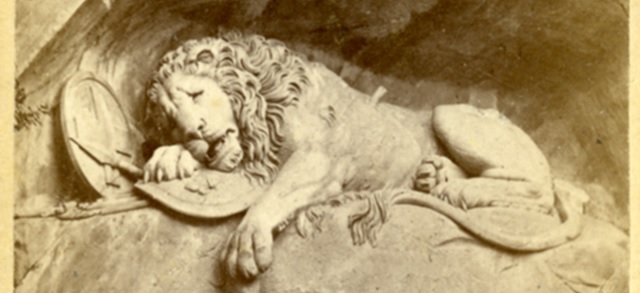
Monuments Class Projects
Architect/Sculptor of Monument
Lorenzo Bartolini (1777-1850) and Giovanni Battista Cevasco (1817-1893)
Preview

Medium
photograph, carte-de-viste
Keywords
Christopher Columbus, Genoa, explorer, Age of Exploration, Discovery of America
Physical Dimensions
2 1/2 x 4"
Date of Publication
1862
Date of Publication
c. 1862-90
Name of Monument
Columbus Monument
Date of Creation of Monument
1862
City of Monument
Genoa
Location within City
Piazza Acquaverde
State/Province of Monument
Liguria
Country of Monument
Italy
Description
This monument is located in Genoa, Italy, where Christopher Columbus is thought to have been born, and it honors his expeditions that connected Europe to the Americas. Created in the Neoclassical style, it stands in Piazza Acquaverde, and celebrates Genoa's naval history and civic pride.
School of Art/Architecture
Neoclassical
Publisher
Alfredo Noack (1833-1895)
Digital Date
4-22-2025
File Size
https://scholarworks.uni.edu/his_monuments_sp2022/80/



Comments
Background
The Columbus Monument in Genoa, Italy, is dedicated to Christopher Columbus (1451-1506), the Italian explorer recognized for beginning European contact with the Americas. Erected in 1862, the monument honors Columbus’s expeditions and represents Genoa’s connection to one of its most well-known historical figures. The monument celebrates Genoa’s maritime history and reflects Italian national pride during the 19th century.
The monument was designed during the mid-19th century, when Italy was in the process of unification (1861-70). This national movement encouraged the celebration of Italian figures who influenced world history. Both private and public donations funded the project, which was designed by sculptors Lorenzo Bartolini (1777-1850) and Giovanni Battista Cevasco (1817-1893). Bartolini created the original design, but after his death, his partner, Cevasco, finished the sculpture.
The monument was placed in Piazza Acquaverde, a public square near the Genoa Principe Railway Station, so that many tourists and residents pass by it. Piazza Acquaverde has both cultural and historical significance and has become an essential gateway to Genoa, because of its location near the railway station, built in 1868. The monument bolsters Genoa’s reputation as a center of trade and exploration by honoring its most famous son.
This monument is an example of the Neoclassical style, which was the main school of European sculpture during the 19th century. It features a marble statue of Columbus on a pedestal. The pedestal is decorated with reliefs that depict significant moments from Columbus' voyages, when he sailed across the Atlantic Ocean from Spain to the Caribbean and Central and South America four times between 1492 and 1502.
The four carved sculptures at each corner of the monument symbolize the impact of Columbus’s voyages and accomplishments. One is a Native American woman, who represents the Americas and the Indigenous people whom Columbus encountered. Her expression and posture show both curiosity and the transformation of the New World after European colonization. Another is a wise old man, who symbolizes knowledge and experience, particularly with the wisdom of Europe. The third is the young explorer, who represents both discovery and adventure, embracing the spirit of the Age of Exploration. Last, there is a seaman who depicts the skills and courage of the sailors who staffed Columbus’s voyages. The female figure kneeling beside Columbus represents America. She is depicted as a young, bare-chested woman who is holding a crucifix and kneeling before Columbus.
“A Cristoforo Colombo, La Patria,” is inscribed on the statue, meaning “to Christopher Columbus, from his Homeland.” This highlights the city of Genoa’s pride in Columbus as a native son. Traditionally, it has been thought that he was born in Genoa in 1451, but there are ongoing debates about where his actual birthplace was. Other alternative theories suggest that he could have been from Portugal, Galicia, or Catalonia. These alternative claims appear from discrepancies in Columbus’s writing and historical records, though many historians favor his Genoese origin. Although Genoa didn’t finance his voyages, the city celebrates him as an icon and a symbol of the city’s maritime legacy. Another relief on the monument portrays Columbus showing his plans to King Ferdinand and Queen Isabella of Spain, who supported his journeys. The monument reflects how Europeans in the 19th century admired Columbus for the role he played in connecting the Old and New Worlds.
Over the years, the Columbus Monument has remained mostly unchanged, despite modern debates and discussions in Latin America, the United States, and Italy about his legacy, particularly regarding its violations of indigenous rights and the negative legacies of colonialism. Many see the monument as a tribute to Genoa’s maritime history and heritage, but others criticize it for raising up a figure whose brutality against people has long been exposed. Unlike similar statues in Latin America and the United States that have been changed or removed, the Genoa monument remains a historical landmark.
Sources:
Clerici, Naila. “Italy Celebrates Columbus: The Indian Rediscovered.” American Indian Culture and Research Journal, 25 July 2023.
History.com Editors. “Christopher Columbus - Facts, Voyage & Discovery.” History.com, A&E Television Networks, 27 Feb. 2025.
M"emorials and Footprints of Columbus" on JSTOR, www.jstor.org/stable/196362. Accessed 15 Apr. 2025.